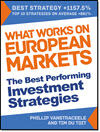Relying on a single ratio like Price-to-Book (P/B) to find undervalued stocks can lead to costly mistakes. This article explains why P/B is outdated in today’s economy, especially with the rise of intangible assets, and how it often flags distressed companies rather than undervalued ones.
You’ll learn about the smarter alternative: the Quant Value Composite, a powerful tool that combines five proven ratios to give a complete and reliable picture of a company’s value. By using this approach, you can avoid value traps, make better decisions, and position yourself for stronger, more consistent long-term returns.
Estimated Reading Time: 6 minutes
You might think that using a single ratio like price-to-book (P/B) ratio is a foolproof way to find undervalued stocks.
It’s a popular ratio, but the truth is, it doesn’t always work. In fact, if you focus on just one ratio—like P/B—you could miss key details about a stock and make costly mistakes.
That’s why a better approach is to use multiple ratios combined into one, like the Quant Value Composite, but more on that later.
Why P/B Falls Short Today
The price-to-book (P/B) ratio was once a cornerstone of value investing, especially for companies with tangible assets like factories, machinery, and inventory. It worked well in simpler economies where a company’s book value closely reflected its actual worth.
But today, the world is different. Many of the most successful companies—like Apple, Amazon, and Nike—derive their value from intangibles such as brand strength, intellectual property, research and development, and customer loyalty.
The P/B ratio doesn’t capture these critical drivers of modern business value.
James O’Shaughnessy, in his extensive research, found that the P/B ratio has become outdated. In fact, his team removed P/B from their value composites after studying its performance in modern markets.
They discovered that P/B often flagged companies with low-quality financials—businesses at risk of bankruptcy—leading to poor investment outcomes. O’Shaughnessy noted that while P/B might have been effective decades ago, its ability to assess value has eroded in today’s economy.
For example, during a 36-year period from 1927 to 1963, companies in the lowest P/B decile (the cheapest stocks) underperformed every other group ranked by P/B.
Instead of showing you undervalued opportunities, the lowest P/B often identified businesses in distress. This performance was further worsened by structural shifts in the economy and the increasing dominance of intangible assets in corporate balance sheets.
Research by O’Shaughnessy Asset Management (OSAM) highlighted how the flaws in P/B have compounded over time. Their work revealed that P/B’s inconsistent performance across market cycles was largely due to its inability to adapt to these economic changes. They also found that even with adjustments, P/B remained a weak predictor of future returns compared to other valuation ratios or composite models.
Click here to start using the Quant Value Composite in your stock screens NOW! - Click here
P/B and the Myth of Simplicity
Another key problem is the perception that P/B is a “simple” metric for identifying value stocks.
As O’Shaughnessy explained, simplicity doesn’t equal reliability. In fact, overly simplistic ratios can mislead investors by ignoring critical nuances. For instance, P/B assumes that assets like goodwill or R&D—which are vital to companies in technology, consumer goods, and healthcare—have little or no value.
This outdated assumption makes P/B irrelevant for evaluating modern companies.
P/B Conclusion
If you rely on P/B today is like using an old map to navigate a new city, it will lead you astray.
Modern markets require modern tools, and metrics like the Quant Value Composite are better suited to capture the true value of companies in today’s economy.
By focusing on composites that incorporate multiple ratios, you’ll avoid the pitfalls of outdated metrics like P/B and position yourself for higher more consistent long-term returns.
A Smarter Alternative: The Quant Value Composite
The Quant Value Composite solves the problems of single ratios like P/B. It combines multiple valuation measures into one easy-to-use score, giving you a complete picture of a company’s value.
This composite approach avoids the limitations of outdated metrics and helps you avoid common mistakes.
How It Works
The Quant Value Composite ranks companies based on five proven valuation metrics:
- Price to Sales (P/S): Lower is better.
- Price to Earnings (P/E): Lower is better.
- EBITDA Yield (EBITDA to Enterprise Value): Higher is better.
- Free Cash Flow (FCF) Yield: Higher is better.
- Shareholder Yield: Higher is better.
Each company gets a score for these metrics, which are combined into a single composite value. This score ranks companies from 1 (best) to 100 (worst).
Why It’s Better
Research shows that composite models outperform single ratios in most market cycles.
For example, over 26 years, O’Shaughnessy’s team found composite ratios outperformed the market in 87% of all five-year periods. They were also consistently among the top three strategies .
By excluding, the Quant Value Composite avoids value traps and focuses on the metrics that matter most.
How to Use It
The Quant Value Composite is easy to use in the screener:
- Screen Top Companies: Adjust the slider to focus on the top 10% of companies by Quant Value Composite score.
- Sort Results: Add the composite score as a column to compare companies.
- Test It: Use the historical screener to back-test your strategy.
This flexibility lets you identify high-potential stocks while avoiding outdated measures like P/B.
The Bottom Line
The idea that one perfect ratio can guide all your investments is a myth. Successful investing requires a balanced approach. The Quant Value Composite combines multiple metrics into a single score that’s reliable, flexible, and proven to work.
By using tools like this, staying diversified, and focusing on the big picture, you’ll make better decisions and avoid common traps.
Investing is a journey and having the right tools to make decisions makes all the difference.
Click here to start using the Quant Value Composite in your stock screens NOW! - Click here
FREQUENTLY ASKED QUESTIONS
1. Why can’t I just rely on the Price-to-Book (P/B) ratio to find undervalued stocks?
The P/B ratio worked well decades ago when companies’ assets were mostly tangible, like factories or equipment. But today, businesses like Apple and Amazon derive value from intangibles like brand strength and intellectual property, which P/B doesn’t account for. Relying solely on P/B can lead you to invest in struggling companies with poor financials, not undervalued gems. A better approach is to use multiple valuation metrics.
2. What’s wrong with using just one ratio, like P/E or P/B, to pick stocks?
Single ratios are too simplistic and miss key details about a company. For example, P/B often ignores critical drivers like research and development or customer loyalty. Modern markets are complex, and using a composite score—like the Quant Value Composite—lets you combine multiple metrics for a fuller picture of a company’s value.
3. How is the Quant Value Composite different from other valuation methods?
The Quant Value Composite combines five proven metrics—P/S, P/E, EBITDA Yield, Free Cash Flow Yield, and Shareholder Yield—into one score. This composite approach avoids the limitations of single ratios like P/B, making it more reliable across different market conditions. Research shows it outperforms single metrics in 87% of five-year periods.
4. If P/B is outdated, does that mean all value investing is dead?
Not at all! Value investing has evolved. While metrics like P/B have become less reliable, using advanced tools like the Quant Value Composite keeps value investing alive and well. By combining multiple factors, you can still find undervalued stocks without falling into value traps.
5. How can I avoid value traps when picking stocks?
A value trap is when a stock looks cheap based on outdated metrics like P/B but is actually cheap for a reason—like declining business or financial distress. Using a composite model like the Quant Value Composite helps you avoid these traps by evaluating a company across multiple dimensions, such as earnings, cash flow, and shareholder returns.
6. How do I use the Quant Value Composite in practice?
It’s straightforward:
- Screen Top Companies: Focus on the top 10% of companies ranked by the Quant Value Composite score.
- Sort Results: Add the composite score as a column in your screener for easy comparison.
- Back-Test Your Strategy: Use historical data to test how well the composite performs over time.This process helps you identify high-potential stocks and avoid outdated, risky metrics.
7. Why should I trust the Quant Value Composite over traditional methods?
The Quant Value Composite is backed by extensive research. It’s been proven to outperform single ratios in most market cycles and across decades of data. Its ability to adjust to modern markets and avoid outdated metrics like P/B makes it a more reliable tool for identifying undervalued opportunities and driving consistent, long-term returns.
Click here to start using the Quant Value Composite in your stock screens NOW! - Click here


